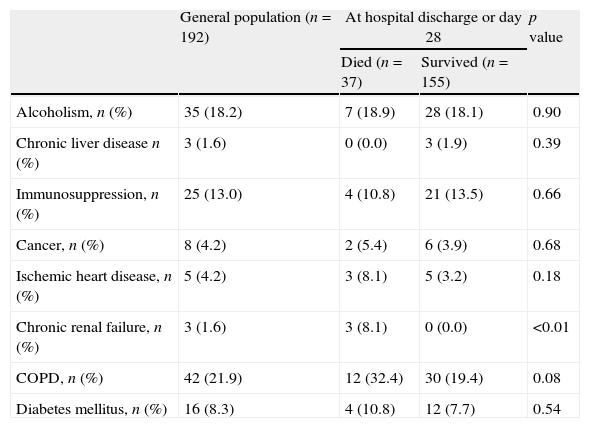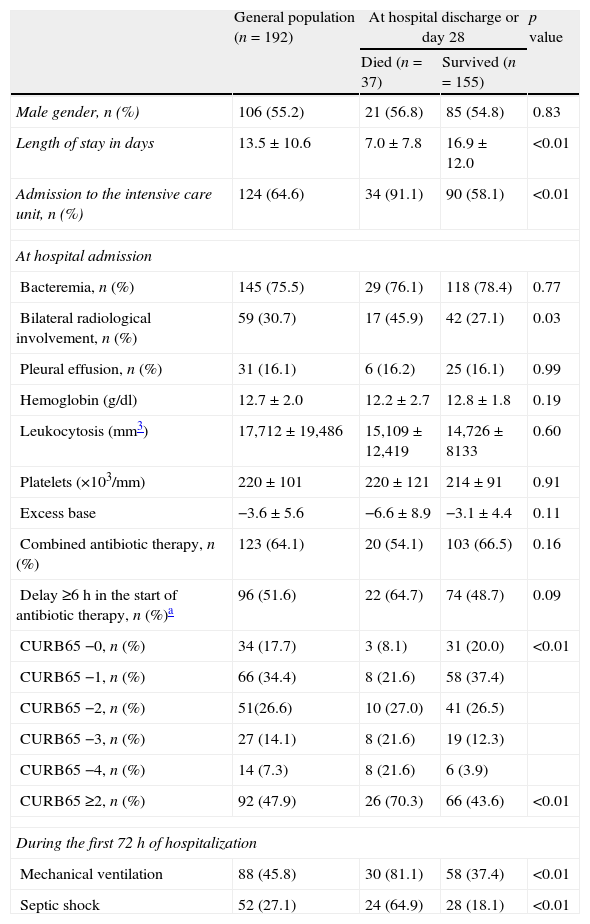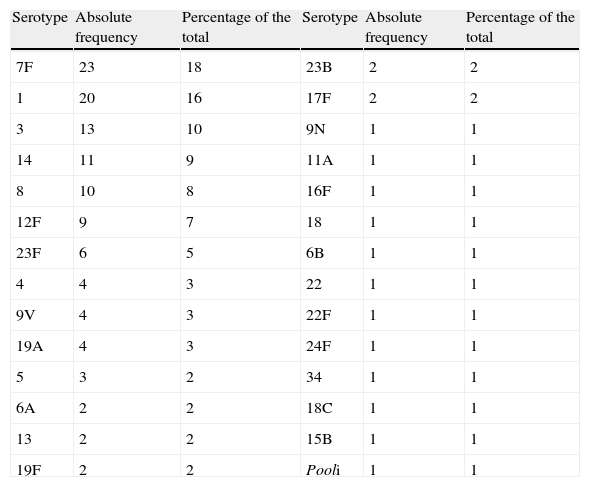The objectives of the present study were: (a) to describe the mortality rate and its associated variables in community-acquired pneumoniae (CAP) due to Streptococcus pneumoniae (S. pneumoniae), (b) to identify therapeutic issues to improve, (c) to describe the main serotypes of S. pneumoniae and (d) to know the potential coverage of antipneumococcal 23-valent vaccine.
Materials and methodsInclusion criteria were age >16 years-old hospitalized due to PAC. Pneumococcal PAC etiology was considered if S. pneumoniae was isolated from blood culture and/or positive capsular urinary antigen detected at hospital admission. Exclusion criteria were patients who refused participation and/or pneumococcal infection diagnosis was made within the last month before hospital admission.
ResultsA total of 192 patients were included, mean age 54.6±19.2 years. The most frequent comorbidities were diabetes, COPD and immunosupression. There were 147 patients with bacteremia. The most frequent serotypes were 7F, 1 and 3. Beta-lactamic resistant microorganisms were not identified and only 8 (5.4%) strains were erythromycin-resistant. Potential anti-pneumococcal 23-valent vaccine coverage was 93%. Thirty-seven patients died. Variables associated with mortality were shock within the first 72h of hospital admission (OR: 7.51; 95% CI: 2.94–19.17) and antibiotic delay ≥6h (OR: 2.47; 95% CI: 1.00–6.17).
ConclusionsPneumococcal pneumonia mortality was 19.3%. Septic shock and antibiotic delay ≥6h since hospital admission were associated with hospital mortality. The most frequent serotype was 7F. The potential anti-pneumococcal vaccine coverage is almost 90%.
Los objetivos fueron: (a) describir la mortalidad y sus variables asociadas en la neumonía aguda comunitaria (NAC) a Streptococcus pneumoniae (S. pneumoniae); (b) identificar aspectos terapéuticos a mejorar; (c) identificar los principales serotipos de S. pneumoniae, y (d) conocer la cobertura potencial de la vacuna antineumocócica 23 valente.
Material y métodoCriterio de inclusión: NAC en pacientes mayores de 16 años. Se consideró NAC neumocócica si al ingreso hospitalario se aisló S. pneumoniae desde la sangre y/o se detectó la presencia de antígeno neumocócico capsular en orina. Criterios de exclusión: negativa al consentimiento informado o infección neumocócica en el mes previo al ingreso.
ResultadosSe identificaron 192 pacientes con edad promedio de 54,6±19,2 años. Comorbilidades más frecuentes: diabetes, EPOC e inmunodepresión. Se detectaron bacteriemias en 147 pacientes. Los serotipos más frecuentes fueron: 7F, 1 y 3. Ninguna cepa fue resistente a los betalactámicos y 8 (5,4%) a la eritromicina. Cobertura potencial de la vacuna antineumocócica 23 valente: 93%. Fallecieron 37 pacientes. Variables asociadas a la mortalidad: shock en las primeras 72h desde el ingreso al hospital (OR: 7,51; IC 95%: 2,94–19,17) y demora en el inicio de la antibioticorapia ≥6h (OR: 2,47; IC 95%: 1,00–6,17).
ConclusionesLa mortalidad de la NAC neumocócica fue del 19,3%; las únicas 2 variables asociadas a ella fueron el shock séptico y la demora ≥6h en el inicio de la antibioticoterapia. Adicionalmente el mencionado retraso constituye el principal factor terapéutico a mejorarse en el futuro. El serotipo más frecuente fue el 7F. La cobertura potencial de la vacuna 23 valente es cercana al 90%.
Article
Diríjase desde aquí a la web de la >>>FESEMI<<< e inicie sesión mediante el formulario que se encuentra en la barra superior, pulsando sobre el candado.

Una vez autentificado, en la misma web de FESEMI, en el menú superior, elija la opción deseada.

>>>FESEMI<<<









